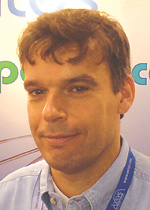 Oderkerk... keeping things simple. |
At Avantes, we specialise in spectroscopy, and this is a field that is just beginning to realise that usability is as important as what the product itself can actually do.
Around 20 years ago, a spectrometer consisted of a large box packed with mechanical components. The user would have to place the sample in the box, where a slowly rotating grating would scan the sample through the whole spectrum. The process was slow, the equipment was cumbersome, and it was only ever used by specialist engineers.
The first revolution was to make the spectrometers smaller and faster, as well as remove the need for moving elements. This had several advantages, not least of which was the fact that the products became more reliable.
Right now, we are on the verge of a second revolution in spectroscopy. As recently as 10 years ago, we had to explain to customers exactly what a spectrometer was and what it could do for them. Nowadays, we are approached by people who not only know that they want a spectrometer, but who are demanding more features and functions. All-in-one spectrometers are also replacing older technologies in areas such as blood analysis. Where previously a rotating filter wheel (i.e. a moving part) would have been used, necessitating a change of filter each time a different characteristic of the blood needed to be analysed, this has now been replaced by the simpler, more compact functionality of the spectrometer. This increased awareness of spectroscopy means that we need to make our products more competitive – and part of this is to improve usability.
Digital cameras have emerged as a major consumer product in the past 10 years or so. We monitor these developments very closely, as we see parallels between digital cameras for consumers and spectrometers for engineers. At a very basic level, both are involved in capturing image data and processing it accordingly.
To this end, spectrometers that are now being developed have elements you would expect to find on digital camera. For example, we have a product that incorporates an onboard SDRAM card, which enables huge volumes of data to be stored on the device itself. This is a significant advantage for engineers needing portability and flexibility. For example, a scientist wishing to collect data for a nature project in a remote part of the Antarctic can now leave a spectrometer in position for months, and then later retrieve the data from the onboard SDRAM card. There's no need for the device to be continuously connected up to a PC for that data to be analysed.
The onboard SDRAM card is just one example of improved usability. Spectrometers can now come with wireless communication, USB2 interfaces, and multi-channel synchronisation, all of which help engineers integrate the device into their own set-ups much more easily.
It's not just improved connectivity that makes life easier, but also the associated software. Far too often in the past, software has been proprietary and complex. Manufacturers across the photonics industry are coming to realise that users don't want to have to learn a new piece of software from scratch every time they buy a new product. They actually want familiarity. This is why software now needs to be Windows-based, have easy click-on menus, and remove the need for unwieldy manuals. In fields such as spectroscopy, which incorporates data analysis, the software can also use elements of existing programmes, such as Microsoft Word and Excel, which will already be familiar to most users.
None of these features and functions is particularly new in themselves; they have been used in other, more mainstream sectors for a number of years. As an industry, photonics needs to realise that, when it comes to usability, it can learn from these other sectors since, ultimately, a user-friendly product will always be more attractive – whether you're a consumer on the high street or physicist in a laboratory.

